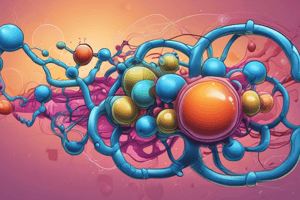Podcast
Questions and Answers
What is gluconeogenesis?
What is gluconeogenesis?
- The storage of glucose
- The process of glycolysis
- The making of glucose from pyruvate (correct)
- The making of glycogen
In which step of the TCA cycle is GTP generated?
In which step of the TCA cycle is GTP generated?
- Step 1
- Step 5 (correct)
- Step 7
- Step 3
What is the main function of the enzyme oxidoreductase in the TCA cycle?
What is the main function of the enzyme oxidoreductase in the TCA cycle?
- To remove carboxyl groups
- To catalyze oxidation-reduction reactions (correct)
- To add phosphate groups
- To ligate two molecules together
Which molecule is regenerated in the last step of the TCA cycle?
Which molecule is regenerated in the last step of the TCA cycle?
What happens during the link reaction in the TCA cycle?
What happens during the link reaction in the TCA cycle?
Which step in the TCA cycle specifically involves the removal of the second carbon dioxide molecule?
Which step in the TCA cycle specifically involves the removal of the second carbon dioxide molecule?
What is produced when breaking thioester bonds in step 5 of the TCA cycle?
What is produced when breaking thioester bonds in step 5 of the TCA cycle?
Which reaction type is involved in step 7 of the TCA cycle?
Which reaction type is involved in step 7 of the TCA cycle?
Which part of the mitochondria contains the electron transport chain protein complexes?
Which part of the mitochondria contains the electron transport chain protein complexes?
Which molecule is reduced to form water at complex five in the electron transport chain?
Which molecule is reduced to form water at complex five in the electron transport chain?
What is the primary role of ATP synthase in the electron transport chain?
What is the primary role of ATP synthase in the electron transport chain?
What drives the ATP generation by ATP synthase?
What drives the ATP generation by ATP synthase?
How do electrons transfer energy in the electron transport chain?
How do electrons transfer energy in the electron transport chain?
What happens to the energy level of electrons as they pass through the protein complexes?
What happens to the energy level of electrons as they pass through the protein complexes?
Why are cofactors necessary in the protein complexes of the electron transport chain?
Why are cofactors necessary in the protein complexes of the electron transport chain?
Which molecules donate electrons to the electron transport chain?
Which molecules donate electrons to the electron transport chain?
Study Notes
Oxidative Phosphorylation: Electron Transport Chain
- Exploiting the transport of electrons between protein complexes to generate ATP.
- Inner membrane of mitochondria contains protein complexes (1-5) with cofactors, including metal ions.
- Each complex contains non-protein chains that pass electrons from NADH or FADH2 to molecular oxygen, leading to the reduction of O2 to H2O.
- Protein complexes transfer energy from electrons to pump protons, creating a gradient.
- ATP synthase allows protons to pass out of the space, converting ADP + Pi to ATP.
How the Electron Transport Chain Generates ATP
- Transferring energy from electrons.
- Generating a high concentration of protons in the inner membrane space.
- Exploiting the high concentration of protons to generate ATP.
How the ETC Makes ATP
- Energy is transferred to protein complexes.
- Electrons are passed down through complexes, losing energy with each step.
- This generates a different conformational state in complexes, funneling H+ ions into the mitochondrial membrane space.
- The flow of protons out of the space is used by ATP synthase to generate ATP.
Cell to Systems
Citric Acid Cycle
- Gluconeogenisis: making glucose from pyruvate.
- Glycogenis: making glycogen.
Citric Acid Cycle
- Glycolysis: 150 kJ/mol ATP in the presence or absence of oxygen.
- TCA: oxidizing carbons.
TCA: 4-Carbon Trains
Step 0: Preparation Step
- Breaks down the 3-carbon chain, releasing 1 molecule of CO2 to generate 2 carbon molecules.
Step 1: Link Reaction
- Takes the 3-carbon pyruvate molecule, removing the carboxylic group and generating CO2.
Step 2: Isomerisation Reaction
- Changes the positions of H, generating and subtracting the same molecule.
Step 3
- Removes the second CO2 molecule, going from a 6-carbon chain to a 5-carbon chain.
- 6C → 5C + CO2 is a redox reaction.
Step 4
- Removes carbon and generates CoA, generating more NADH for oxidative phosphorylation.
- The enzyme is oxidoreductase.
Step 5
- Generates GTP through substrate level phosphorylation.
- GDP + Pi = GTP, breaking thioester bonds-COA.
- The enzyme used is a ligase.
Step 6
- Regenerates the full carbon chain, generating more NADH and FADH2.
Step 7
- Involves a redox reaction and a ligase reaction in making or breaking double carbon bonds.
Step 8
- Regenerates oxaloacetate through a redox reaction, generating more NADH.
TCA Summary
- Steps 1-6: Regenerating the full carbon chain by removing electrons for oxidative phosphorylation.
- Step 7: Making or breaking double carbon bonds.
- Step 8: Generating NADH.
TCA Cycle: 8 Steps + Preparation
- Pyruvate → Acetyl-CoA, generating CO2 and NADH.
Studying That Suits You
Use AI to generate personalized quizzes and flashcards to suit your learning preferences.
Description
Learn about the process of generating ATP through the transport of electrons between protein complexes in the mitochondria's inner membrane.


